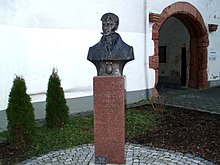Principality of the Leyen
|
||||||||||||||||||||||||||||||
The Principality of von der Leyen was a small state in southwest Germany that existed from 1806 to 1813 and was a Rhineland federal state under the protectorate of the Emperor of the French . It fell to the Grand Duchy of Baden in 1818 .
history
The principality was established in 1806 as the successor to the County of Hohengeroldseck and was surrounded by Baden territory. The small state owed its existence to the fact that Count Philipp Franz von der Leyen was a nephew of the Grand Duke of Frankfurt, Prince Primate Karl Theodor von Dalberg . The principality was a member of the Napoleon- dominated Rhine Confederation . The sovereign principality with its 4500 inhabitants was two and a half square miles in size and divided into nine bailiwicks , which were under an upper office. The main town was Seelbach (Schutter) , but the princely residence was in Arenfels Castle on the Rhine.
After the Battle of the Nations near Leipzig , Prince Philipp, who had lived in Paris for years , did not join the coalition led by Prussia , Russia and Austria . Therefore Hohengeroldseck was drafted on December 12th, 1813 as "ownerless land" and placed under the administration of the victorious powers. When Prince Philipp later tried to join the coalition, this was now denied him.
Hohengeroldseck came to Austria through the Congress of Vienna in 1815 . At the Aachen Congress in 1818, it came to the Grand Duchy of Baden through an exchange of territory : Baden received Hohengeroldseck, in return it ceded the Steinfeld office to Austria, which in turn left it to the Kingdom of Bavaria . Hohengeroldseck was handed over to Baden on October 4, 1819. The area was initially administered as the “Provisional Office Hohengeroldseck” until it was added to the Lahr Office on March 1, 1831 .
See also
literature
- Gerhard Köbler : Historical lexicon of the German countries. The German territories and imperial immediate families from the Middle Ages to the present. 5th, completely revised edition. CH Beck, Munich 1995, ISBN 3-406-39858-8 , pp. 196-197.
- Johann Andreas Damian: Statistics of the Confederation of the Rhine , Volume 2, Frankfurt (Varrentrapp and Son) 1812, page 382f.
- Karl Heinrich Ludwig Pölitz : Handbook of the history of the sovereign states of the Rhine Confederation , Leipzig 1811, Volume 2, pp. 298-302.
Individual evidence
- ↑ Contains the Grand Duchies, pp. 301 f.



